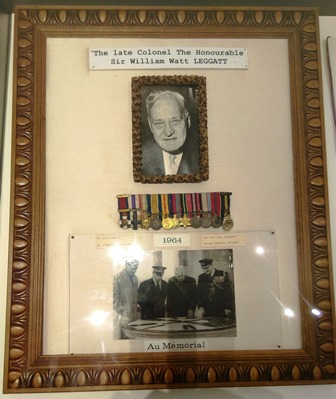LEGGATT, Sir William Watt, MC DSO (1894-1968) Wiki.jpg)
Sir William Leggatt
Sir William, Leggatt, lawyer, soldier and parliamentarian, was a State Cabinet Minister and Agent-General for Victoria in London. He was born on Malekula Island in the New Hebrides (Vanuatu), and was the eldest child of a Scottish missionary Thomas Watt Leggatt and Margaret Muter nee Wilson. After his father returned to his parish at Dunolly, William attended the College from 1908 to 1912 and was a member of the 1st Rowing VIII and a School Prefect in 1912. From College he entered Ormond College and studied firstly for a BA and then completed a degree in law in 1920.
Although he won a scholarship to enter the ministry he instead enlisted in the AIF in 1915,
‘2nd Divisional Signalling Company, embarking on HMAT A40 Ceramic on 23 November 1915. He served in France where he transferred to 59 Battalion, and was promoted from Sergeant to 2nd Lieutenant on 27 July 1916. He served through the operations in France, at Pozieres, Bullecourt, Ypres, Polygon Wood, Villers Bretonneux, Amiens, and was awarded his Military Cross on 8 August 1918, while attached to 5th Division Signal Company: “He organised and prepared Brigade communications in connection with the attack on the Villers Bretonneux front and on the morning of 8 August 1918. Half an hour after Zero Hour on that date he moved forward with a party of the Signal Section and established a relay post in a trench 2000 yards from the starting point. In this trench he discovered and, with his party, captured one officer and seven other ranks. About two hours after, he had to move 2,000 yards and established his forward Brigade signal office in P.34.d. Half an hour later under instructions from the Brigadier he moved this office to near Marcelcave. An hour later he moved a further 4000 yards establishing a relay station at V.6.b., and a temporary station at W.S.A. At about noon he moved forward a further 1000 yards and opened his advanced office at W.S.A. From this point communication was established to Battalions and flank brigades. He therefore, during the advance moved his forward office on four occasions between the hours of 4 am and 4 pm. This work was accomplished under most strenuous conditions and heavy enemy shell fire. It was entirely due to his courage, perseverance and keen devotion to duty that communications were satisfactorily maintained within his brigade throughout the advance. He was also responsible for establishing alternate means of communication such as visual, pigeons, air contact etc. He overlooked no details and by his energy succeeded in retaining required communications. He was throughout the operations of the day an excellent example to the men of his Section' .
He was later wounded in the Battle of the Hindenburg Line on 29 September 1918. Leggatt returned to Australia on 9 March 1919, disembarking on 26 June 1919.
During the Second World War, he served as Lieutenant Colonel, Officer Commanding 2/40th Battalion but was taken prisoner on Timor and sent to Changi on 26 July 1942, spending the remainder of the war there. He was awarded the Distinguished Service Order, gazetted on 6th March 1947,
'for outstanding leadership and courage on Timor' . The presentation was made by the Lieutenant-Governor of Victoria, Sir Edmund Herring, on 27 July 1949.

Leggatt plaque at Villers Brettoneux Village Museum (Lannan)
 Wiki.jpg)
Sir William Leggatt, circa 1954.
After briefly investigating war crimes in 1946 he returned to legal practice before winning the seat of Mornington in the Victorian Legislative Assembly and served as Chief Secretary from the end of 1948 to 1950. When Henry Bolte won government in 1955, Leggatt briefly served as Minister of Education and Minister of Immigration before retiring from parliament in 1956 to become Victorian Agent-General in London from 1956 to 1964. He was knighted in 1957.
During the period 1956-64 when Leggatt, served as Victoria's Agent-General in London, he helped build up a small museum in Villers Bretonneux, the Musee Australien. This Museum in the Villers Bretonneux School was formerly known as the 'Sir William Leggatt Museum', and the building bears a plaque with the words:
'This school building is the gift of the school children of Victoria, Australia, to the children of Villers-Bretonneux, as a proof of their love and goodwill towards France. Twelve hundred Australian soldiers, the fathers and brothers of these children, gave their lives in the heroic recapture of this town from the invader on 24 April 1918, and are buried near this spot. May the memory of great sacrifices in a common cause keep France and Australia together forever in bonds of friendship and mutual esteem' .
William Leggatt's father, the Rev Thomas Watt Leggatt, after the war became Moderator of the Presbyterian Church of Victoria. As such on 19 January 1932 he, along with the ex-Presbyterian Chaplain of the 4th Division, Rev Smiley, and the ex-Chaplain from 14 Battalion, Rev Francis Rolland (Principal of Geelong College at that time in 1932), conducted the Memorial Service at Anzac House for Captain Albert Jacka, VC, MC and Bar — arguably Australia's finest fighting soldier.
Sources: Ad Astra March 1969; Excerpt from James Affleck Geelong Collegians’ at the Great War citing Robin S Corfield, Hold Hard, Cobbers (Vol 1); The University of Melbourne: Record of Active Service of Teachers, Graduates, Undergraduates, Officers and Servants (1926); The Pegasus; National Archives; AWM E01426; Geoff Browne, 'Leggatt, Sir William Watt (Bill) (1894 - 1968)', Australian Dictionary of Biography, Volume 15, Melbourne University Press, 2000, pp 77-79.